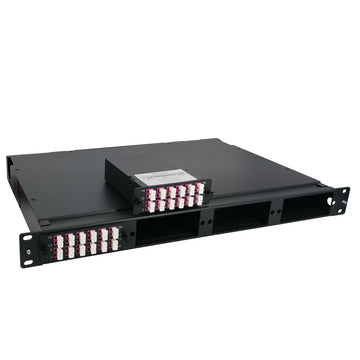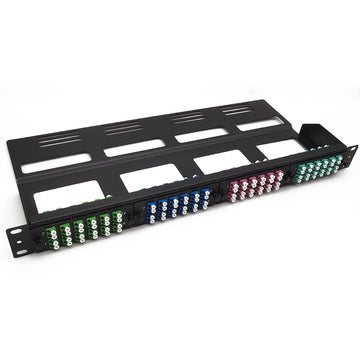Why Not Use Raman Amplifier to Extend the CWDM Network Reach?
In comparison with the long-haul DWDM network that uses the thermo-electric coolers to stabilize the laser emissions essential, CWDM technology employs wider wavelength spacing and less expensive components, allowing the wavelength fluctuation of uncooled directly modulated laser diodes (DMLs). But on the other hand, the CWDM network exists the limitation for the uncooled DMLs’ output power and the additional loss of CWDM Mux Demux and optical add/drop modules. These make the CWDM loss budget limited to < 30 dB and the CWDM reach within 80 km. Hence, here offers the Raman amplifier (see the following figure) to extend the CWDM network reach, as an ideal solution.
What’s Raman Amplifier?
Raman amplifier is an optical amplifier based on main to be Raman gain, also referred to as RA, which results from the effect of stimulated called as Raman scattering. Different from the erbium-doped fiber amplifier (EDFA) and semiconductor optical amplifier (SOA), the RA intensifies the signals through the nonlinear interaction between the signal and a pump laser within an optical fiber, as shown in the figure below.

Fiber-based Raman amplifiers make use of stimulated Raman scattering (SRS) occurring in silica fibers. Fiber-based Raman amplifiers make use of stimulated Raman scattering (SRS) occurring in silica fibers. The following figure shows how a fiber can be used as a Raman amplifier in the forward-pumping configuration. The pump and signal beams at frequencies ωp and ωs are injected into the fiber through a fiber coupler. During the SRS process, a pump photon gives up its energy to create another photon of reduced energy at the signal frequency; the remaining energy is absorbed by the silica material in the form of molecular vibrations (optical phonons). The energy is transferred continuously fro the pump to the signal through SRS as the two beams co-propagate inside the fiber. The pump and signal beams counter-propagate in the backward-pumping configuration often used in practice.

At present, two kinds of Raman amplifiers are available on the market, the distributed and lumped Raman amplifiers. As for the distributed Raman amplifier (DRA), it uses the optical fiber as the gain medium to multiplex the pump wavelength with signal wavelength, so that the optical signals can be boosted. With regard to the lumped one (LRA), it requires a shorter length of optical fiber for the signal amplification. Both of these two Raman amplifiers are suitable for amplifying CWDM signals and extending the CWDM network reach.
Why Raman Amplifier Is Used for Amplifying CWDM Signals?
As we know, the EDFA and SOA are able to strengthen the CWDM signals. But why it is not recommendable for the CWDM network? In fact, they can not perform as well as the RA in the CWDM network for some limitations, which can be learned from the following figure.
| EDFA | SOA | RA | |
| Wavelength Range | 1530-1590nm | 1470-1610nm | 1470-1610nm |
| Saturation Power | >20 dBm | ~13 dBm | >18 dBm |
| Net Gain | >15dB | >10dB | >10dB |
| Noise Figure | <6 dB | <8 dB | <6.5dB |
| Polarization Dependent Gain | 0.3dB | 0.5dB | 0.3dB |
CWDM technology employs wider wavelength spacing and less expensive components than does long-haul DWDM. DWDM's narrower channel spacing makes the use of thermo-electric coolers to stabilize the laser emissions essential. Here are some advantages of Raman amplifier :
- Compatible with installed SM fiber.
- Variable wavelength amplification possible.
- A very broadband operation may be possible.
- Lower crosstalk.
- Can be used extends EDFAs full form.
How Does Raman Amplifier Benefit CWDM Network?
In order to study the benefit of RA for the CWDM network, here offers two sets of research data about the receiver sensitivity, for a bit-error rate (BER) of 10-9 using a pseudo-random bit sequence (PRBS) with a 231-1 word length.
| Without RA(dBm) | With RA(dBm) | ||||
| Back-to-back | SMF 100km | Back-to-back | SMF 100km | SMF 150km | |
| 1511nm | -35.2 | -34.1 | -35.2 | -34.4 | -33.6 |
| 1531nm | -34.5 | -33.9 | -34.4 | -34.2 | -32.6 |
| 1551nm | -34.4 | -32.6 | -34.2 | -33.2 | -32.6 |
| 1571nm | -33.3 | -31.8 | -32.9 | -32.3 | -31.5 |
From the figure above, we can learn that the first set of data is resulted from the four channel CWDM network without use of the RA, while the second utilizes the RA. In order to check whether the Raman amplifier benefits the CWDM network, we can take the data of 100km CWDM transmission through singlemode fiber (SMF) as an example. The power penalty of the transmission with a RA are separately -34.4 dBm, -34.2 dBm, -33.2 dBm and -32.3 dBm. It is 0.3 dBm better than the power penalty of the transmission without a RA, at least. Except that, we can also learn that the CWDM network with a RA can transmit the signals through the SMF at lengths up to 150m without any repeater stations, while the network without the RA cannot.
Conclusion
The Raman amplifier is an ideal alternative to the repeater in CWDM network, for intensifying the CWDM signals and extending the CWDM network reach. By using the Raman amplifier, the loss budget of the CWDM network can be increased, which finally achieves a longer transmission. Meanwhile, from the view of cost, the RA and the repeater are almost the same, but the repeater stations should cost much more for constructing and maintaining. Moreover, using the RA in the CWDM network can also gain the loss compensation of OADM. Raman amplifier is undoubtedly the best choice to strengthen the CWDM signals and lengthen the CWDM network reach.












